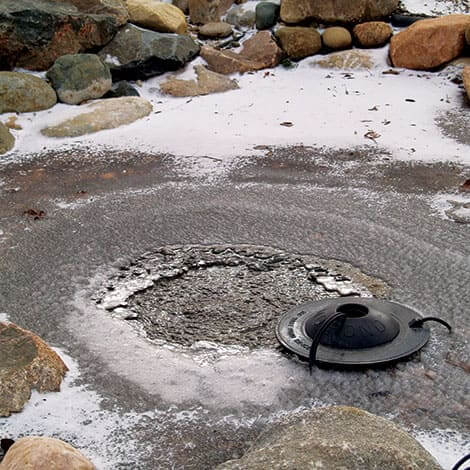Keeping a hole open on the surface of your pond during winter is imperative to your fish's safety. A de-icer maintains an open hole in the ice to allow toxic gases to escape. Finding the correct size de-icer to overwinter your pond is not as difficult as it sounds, but every de-icer is different, so make sure to double check the manufacturer's recommendations. If you have excessive plant material or large amounts of fish overwintering in the pond it may be necessary to have multiple holes in the ice as the gasses will build up quicker.
Sizing Your De-Icer
Which de-icer is best for your situation? It will depend on how many gallons your pond holds, and if you're using it alone or with an aeration system. First, here's what we recommend for de-icers based on the size of your pond:
- Up to 250 gallons: 100 to 250-watt de-icer
- 250 to 500 gallons: 300-watt de-icer
- 500 to 1,000 gallons: 750-watt de-icer
- 1,000 to 1,500 gallons: 1,250-watt de-icer
- 1,500 to 2,000 gallons: 1,500-watt de-icer
Options
Here are the De-Icers we currently offer:
- Farm Innovators Floating Pond De-Icer – Made of cast aluminum this unit is virtually indestructible. The Farm Innovators De-Icer comes with a 10' power cord and runs on 1,250-watts. This de-icer is safe to use in ponds up to 600 gallons whether plastic, liner or concrete.
- Pondmaster 120-Watt Pond De-Icer – The Pondmaster Floating Pond De-Icer uses only 120-watts to prevent toxic gas buildup in ponds up to 250 gallons. It is made of durable plastic and will never get hot enough to burn fish, hands, or your pond liner. The domed top allows the heat to stay where it is needed and the 18' power cord is long enough to get the de-icer to where it needs to be.
- K&H Perfect Climate Pond De-Icer – The Perfect Climate Pond De-Icers have a removable float to allow them to be used as floating or submersed, making them unique from the other de-icers we offer. This de-icer has a 12' power cord and is available in three wattages. There is a handy chart based on the hardiness zone and pond size on the Tech Specs tab to help you determine which size you need.
De-Icer Placement
De-icers work best when placed in shallower sections, near the pond's edge. The heat will reflect off the edges and make the deicer more efficient. Having your de-icer close to shore also means that you will not be walking on thin ice to get your de-icer if problems arise.
Blocking as much wind as possible from the de-icer is a good idea if you are in northern areas or places that are known to freeze hard. The wind will take the heat away from the de-icer which will require it to stay on longer to keep up with the cold. Covering a corner of the pond with a piece of plywood and placing the de-icer under it will block the wind and hold in some heat. You can also try placing a bucket with the bottom cut out over the de-icer after the ice has formed. If you have complete ice cover, simply fill a pan with boiling water and place it on the ice until a hole is melted. You never want to chop or saw the ice as the shock waves can stress or even kill your fish.
Maintenance
De-icers do have some upkeep involved to keep them running efficiently. Mineral buildup on the heating element can cause premature failure of the de-icer. Inspect the heating element often and clean it with water and, if necessary, a limescale remover. Never run a de-icer on an extension cord as that will cause loss of voltage and possible premature failure as well.
Extra Protection
Using an aeration kit, like the PondAir, in combination with a de-icer will not only help keep a hole at the surface, but will also add oxygen and circulate the water to help push the toxic gas out. Infusing a constant supply of dissolved oxygen will keep your fish happy and well throughout the winter. To help you save on energy costs, consider using the Thermo Cube Thermostatically Controlled Outlet. It is controlled by air temperature, meaning you will only use your de-icer when really necessary.
Pond Heaters Versus De-Icers
Unless you house warm water fish, like Plecostomus, in your water garden, you will not need a pond heater to warm the water. Most pond fish, including koi and goldfish, will overwinter in your pond as long as the depth is at least 18". Koi & goldfish go into a torpor or hibernation: their metabolism slows, they stop eating and they are able to tolerate cooler water—even water that's frigid enough to freeze.
